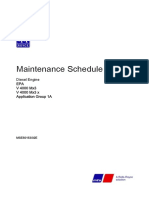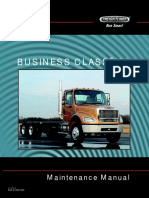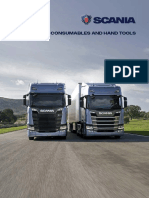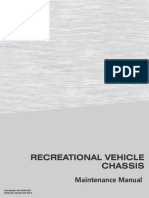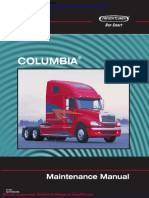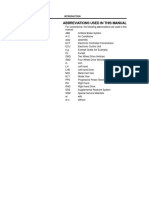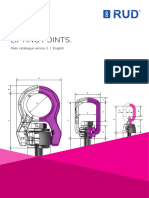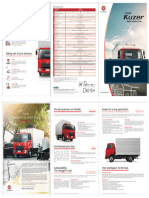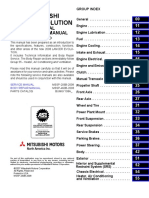WSM 0003098 01
WSM 0003098 01
Uploaded by
Ahmad HisyamCopyright:
Available Formats
WSM 0003098 01
WSM 0003098 01
Uploaded by
Ahmad HisyamOriginal Title
Copyright
Available Formats
Share this document
Did you find this document useful?
Is this content inappropriate?
Copyright:
Available Formats
WSM 0003098 01
WSM 0003098 01
Uploaded by
Ahmad HisyamCopyright:
Available Formats
00:16-30
Issue 8 en-GB
Carrying out maintenance
300 511
© 2020 Scania CV AB Sweden
Changes from the previous issue ................................................... 3
Why maintenance is important ........................................................ 4
Purpose of this document .............................................................................. 4
Purpose of maintenance ................................................................................ 4
Maintenance programme ................................................................... 5
Preface to maintenance programme .............................................................. 5
Maintenance forms ........................................................................................ 6
Maintenance instructions .............................................................................. 7
General documents ........................................................................................ 7
IT ................................................................................................................... 8
Reflex ............................................................................................................ 8
SDP3 ............................................................................................................. 8
Scania Multi .................................................................................................. 8
Maintenance area and workflow ..................................................... 9
Maintenance area design ............................................................................... 9
Workflow for good work environment and efficiency ............................... 14
© 2020 Scania CV AB Sweden
Changes from the previous issue
Changes from the
previous issue
Maintenance programme Updated information.
Preface for buses 00:27-01 has been added.
Maintenance instructions Updated information.
IT SAIL replaced by Reflex.
SAIL Removed.
SDP3 SAIL replaced by Reflex/TIL.
Scania Multi 00:27 has been added.
Operational analysis, MAC and software update Removed.
Maintenance area design SAIL replaced by Reflex.
Permanent equipment SAIL replaced by Reflex.
Tool board location Information on tool boards updated.
Workflow for good work environment and efficiency Updated information.
Maintenance form structure Updated information.
Example of form for optimised workflow Updated information.
00:16-30 Issue 8 © 2020 Scania CV AB Sweden 3 (16)
Why maintenance is important
Why maintenance
is important
Purpose of this document
This document is a summary of what should be
taken into consideration when planning and
carrying out maintenance.
Planning the work makes it more efficient and
productive. This leads to shorter downtime for
the vehicle and higher capacity for the work-
shop.
Purpose of maintenance
A Scania vehicle is designed to provide good
transport economy. However, regular mainte-
nance is necessary to:
• maintain road safety
• prevent unplanned stops
• extend the vehicle service life
• reduce the environmental impact as much as
possible
• provide the best possible total economy.
00:16-30 Issue 8 © 2020 Scania CV AB Sweden 4 (16)
Maintenance programme
Maintenance Preface for trucks
programme
For trucks, the periodic maintenance pro-
gramme is designed for 6 operation types (0:0-
4), see Preface for periodic maintenance pro-
Scania offers 2 different maintenance pro- gramme (00:16-01) and (00:17-30).
grammes; a flexible maintenance programme
and a periodic maintenance programme. 00:16 was introduced together with the P, G, R
and T series.
The maintenance information consists of pref-
ace, forms and instructions for trucks and buses 00:17 was introduced together with the L, P, G,
and is part of Scania’s workshop literature. R and S series.
Preface to maintenance Preface for buses
programme For buses, the periodic maintenance pro-
gramme is designed for 3 operation types (1-3),
The preface is used as a foundation when creat- see Preface for periodic maintenance pro-
ing an individual maintenance plan. The main- gramme (00:21-50) and (00:27-01).
tenance plan takes factors such as the vehicle’s
application, local conditions and customer 00:21 was introduced together with the F, K
requirements into consideration. and N series.
00:27 was introduced together with the C and
Periodic maintenance K series.
programme
The periodic maintenance programme applies
Flexible maintenance programme
to trucks and buses. The programme is The flexible maintenance programme provides
designed for different operation types and individually adapted maintenance plans. The
operating conditions, from which individually programme is comprised of a number of main-
customised maintenance plans are created. tenance items that are then grouped into a num-
ber of maintenance modules.
The preface contains information about the
maintenance programme structure. It contains The preface contains information about the
information on: modules and the maintenance items included.
The flexible maintenance programme uses
• filter and fluid change intervals operational factors to describe how the vehicle
• operation types is used. Operational factors, their versions and,
to some extent, how they affect the modules
• oil grades.
are described in the preface.
Preface to flexible maintenance programme,
00:22-10, is only available in TIL.
Preface for trucks
For trucks, the flexible maintenance pro-
gramme is designed for a number of opera-
tional factors, see Preface to flexible
maintenance programme (00:22-10).
00:16-30 Issue 8 © 2020 Scania CV AB Sweden 5 (16)
Maintenance programme
Maintenance forms Feedback to the customer
The maintenance programmes both contain a Towards the end of each maintenance form,
number of maintenance items that must be per- there is a notes field that the customer can read
formed at specific intervals. The timing for the after the maintenance is complete.
respective maintenance is determined by the Here, the mechanic can make notes on obser-
maintenance plan, which is based on factors vations from the maintenance event and any
such as the vehicle’s application and under repair needs. An example could be the need for
what conditions the vehicle is driven. renewing brake linings.
The periodic maintenance programme has the
following maintenance forms: S, M, L, X and
XO. The points differ in varying degrees
between maintenance forms and some mainte-
nance items recur in several of the maintenance
forms.
The flexible maintenance programme com-
prises a number of modules with maintenance
items that are arranged in the maintenance
forms. The module forms are relevant for a
specific maintenance event and are structured
according to the same principle as the periodic
maintenance forms. Which modules are con-
cerned for a specific maintenance event are
determined by the maintenance plan, which
means that the contents of the module mainte-
nance forms differ between different mainte-
nance events and vehicles.
A more detailed description of the maintenance
forms with examples of what a maintenance
form can look like is found in section Mainte-
nance form structure.
00:16-30 Issue 8 © 2020 Scania CV AB Sweden 6 (16)
Maintenance programme
Maintenance instructions Safety and fire protection in the
workshop
The maintenance instructions contain step-by-
step instructions, illustrations and more The document Safety and fire protection in ser-
detailed text on how maintenance should be vice workshops (00:01-02) contains warnings
carried out. The maintenance instructions can and safety precautions and applies to all work
be accessed in different ways: in the workshop.
Instructions for the L, P, G, R and S series and The document covers areas such as the follow-
C and K series can be accessed via links in the ing:
maintenance form.
• Safety around the vehicle.
Instructions for the P, G, R and T series can be This covers e.g. safety when tilting the cab,
found via the Maintenance icon in Scania Multi working under the vehicle and working
group 00:16. with heavy equipment.
Instructions for the F, K and N series can be • Safety during mechanical work.
found via the Maintenance icon in Scania Multi This section covers e.g. noise, moving
group 00:21. parts, vibrations, splinters and dust.
General documents • Safety around fluids and flammable sub-
stances.
General documents are found under group 0 in This covers e.g. fire and explosion risks
the Workshop Manual. with different fluids and risks with fluids
and gas under pressure.
Fuel, lubricants and fluids
Fuel, lubricants and fluids (00:16-15) is used as
a reference for all maintenance and indicates
quality requirements and volumes for compo-
nents such as:
• engine oil
• transmission oil
• coolant
• fuel
• lubricant.
00:16-30 Issue 8 © 2020 Scania CV AB Sweden 7 (16)
IT
IT Scania Multi
In order for the mechanic to be able to do their Scania Multi is an aid to quickly and effec-
work, the workshop should be equipped with tively find the right spare parts and correct
the following: workshop information for a vehicle. All infor-
mation related to maintenance is published
• Computer here: Preface, maintenance instructions and
• Internet connection, preferably wireless forms.
• Access to Reflex It is also possible to create chassis-adapted
forms. Use the Maintenance button in the menu
• SDP3
bar to generate chassis-adapted forms and
• Scania Multi overall forms for the maintenance programmes
• Access to Operational analysis and Conver- 00:16, 00:21, 00:17 and 00:27.
sion.
• MAC
Reflex
For more information on access to Reflex, con-
tact your local distributor.
SDP3
SDP3 communicates with Scania vehicles and
is used for operations such as troubleshooting
the vehicle.
For information on use, system requirements
and equipment, refer to the SDP3 user instruc-
tions on Reflex/TIL.
00:16-30 Issue 8 © 2020 Scania CV AB Sweden 8 (16)
Maintenance area and workflow
Maintenance area
and workflow
Maintenance area design
Scania recommends that maintenance is per-
formed at workplaces adapted for maintenance.
More effective maintenance leads to reduced
time required per maintenance event, thus
allowing the workshop to provide increased
coverage. Since time consumption decreases,
this also leads to shorter downtime for the
vehicle and reduced costs for the customer and
the workshop.
A maintenance-adapted workplace is a work
pit with the right equipment, such as an oil dis-
pensing station and jack. For specification of
how the work pit should be outfitted, refer to
the section Permanent equipment in and around
the work pit. Refer to the information from
Real Estate, which can be found in Reflex.
00:16-30 Issue 8 © 2020 Scania CV AB Sweden 9 (16)
Maintenance area and workflow
Permanent equipment
This section describes examples of permanent
equipment that should be found in a mainte-
nance hall.
155 538
Example of maintenance hall.
The work pit must be equipped with stairs at
each end. It is also important for the work pit to
be equipped with good lighting. Safety precau-
tions for lighting and ventilation must be fol-
lowed.
00:16-30 Issue 8 © 2020 Scania CV AB Sweden 10 (16)
Maintenance area and workflow
To achieve good productivity, it is important to
position suitable equipment near the work pit.
This includes:
• Axle lift
• Oil dispensing station
• Hose reels for transmission oil, grease,
water and compressed air
• Drain adapted for waste oil
• Maintenance articles such as filters and
seals.
Refer to the information from Real Estate,
which can be found in Reflex.
Spare parts
Frequently used spare parts, such as fuel filters,
oil filter, seals and maintenance kits, should be
positioned near the work pit. This minimises
the mechanic’s need to move around and
thereby makes the work more efficient.
00:16-30 Issue 8 © 2020 Scania CV AB Sweden 11 (16)
Maintenance area and workflow
Tools in and around the work pit Tool board location
Tools used during maintenance should be posi- Tool boards are marked with a number at the
tioned in and above the work pit to minimise top of the respective tool board. The boards are
the mechanic’s need to move around. This is numbered MB 1, MB 2, MB 3 and MB 4. MB
why 4 tool boards have been developed to stands for Maintenance Board.
make maintenance easier. The tool boards or
• Tool boards MB 1 and MB 2 are vertical
the tool cabinet contain all the necessary tools
and should be positioned above the work
for maintenance, including hand tools and spe-
pit, preferably at its front edge.
cial tools, and can therefore replace the mainte-
nance trolley and mechanics’ trolley if so Tool boards MB 1 and MB 2 are also available
desired. The tool board may also be ordered as as lockable cabinets.
a tool cabinet.
• Tool boards MB 3 and MB 4 are horizontal
The purpose of organising the tools in this way and should be positioned in the work pit,
is to make the work more efficient. Grouping preferably in the centre under the vehicle.
the tools where they are used minimises the
mechanic’s need to move around so much. For current information on tool boards, tools
This results in less time spent on each mainte- and their positioning, see General workshop
nance event. equipment 588 699, which is available via the
Reflex portal.
Tools not found on the tool boards:
Contact your local distributor for more infor-
• Cab strut mation on access to Reflex.
• Lockable cabinet
• Battery tester
• Computer
00:16-30 Issue 8 © 2020 Scania CV AB Sweden 12 (16)
Maintenance area and workflow
Examples of general diagrams for tool
boards
MB 1 and MB 2
A B C D MB 1 A B C D MB 2
587025 / 587025 /
1/2 588365 588365
1 1
2 2
587054
587976
99444
588179
98595
3 3 587050 99442
87770
587071
587441 587028
BATTERYWATER
588584
4 4
FUELBOTTLE
588621
98661 BATTERY
99565 GREASE
588584
OILSPRAY
5 5
588117 587322
587057
6 6
300 692
MB 3 and MB 4
MB 3 588370 87770 MB 4
587072
1/2 1/2 1/2 1/2
588805 99315
587025 / 587025 / 99426 / 99426 /
588365 588365 99432 99432
1/2 99309
588366
587250
Clutch fluid
Oil spray
98075 587299 587300
587637 587301
3/4 588369
155 717
00:16-30 Issue 8 © 2020 Scania CV AB Sweden 13 (16)
Maintenance area and workflow
Workflow for good work Planning work
environment and The mechanic should begin work by planning
based on factors that affect the working proce-
efficiency dure. Examples of such factors are:
It is also important that the workflow is well • where in the workshop the inspection pit is
thought through as this saves time and reduces located
the risk of maintenance items being over-
looked. Other workshop planning is facilitated • the layout of the workshop
if identification of repairs requiring the work- • how the vehicle is specified
shop to contact the customer is done early on in
• the number of mechanics performing the
the maintenance event. An example of such
work
work is replacing brake linings but also other
repairs. • if any parts subject to wear must be renewed
or if the maintenance includes repairs. In
An example of workflow is presented in this such cases, spare parts must be ordered.
section. It is only to be considered an example
since adaptations may be required individually
between workshops and regions and based on
the vehicle specification. Regardless of the
adaptation, the importance of a structured work
sequence is the same to achieve a high level of
productivity.
00:16-30 Issue 8 © 2020 Scania CV AB Sweden 14 (16)
Maintenance area and workflow
Maintenance form structure Example of form for optimised
The maintenance items in the maintenance workflow
forms are structured according to a specific The following example illustrates how work
working procedure. The designed layout is can be structured to make the maintenance
based on experience gained from working with events as efficient and productive as possible.
SRS (Scania Retail System) at Scania work-
shops in Europe. The example shows parts of a form for S main-
tenance with optimised workflow. The form is
The structure in the maintenance forms has based on one mechanic working on the vehicle.
been optimised to reduce the mechanic’s need If more than one mechanic is working on the
to move around. Standard times for mainte- vehicle, then the work sequence may be struc-
nance are also calculated according to this tured differently.
workflow.
The form describes the sequence in which the
The workflow has been designed according to maintenance items should be performed.
the following principles:
In connection with each maintenance item,
• Maintenance items are primarily grouped there is a link to the maintenance instructions
according to location on the vehicle, e.g. or a reference to the main group to which the
maintenance items under the vehicle. This maintenance instructions belong.
results in less time being spent by the
mechanic. Improvements to the workflow will be imple-
mented continuously in the maintenance form.
• Important checks, e.g. checking the brakes
and fault code readout, are performed early
in the workflow. This is to detect any faults
which may lead to repairs. If the customer
needs to be contacted and spare parts
ordered, then this can be done early on.
• The test drive is divided into 2 parts. The
first test drive is done at the start of the
maintenance event to find any faults on the
vehicle. The second test drive is done at the
end of the maintenance event to quality
assure the work performed.
• Check for excessive play in the chassis
components before lubrication is carried
out.
00:16-30 Issue 8 © 2020 Scania CV AB Sweden 15 (16)
Maintenance area and workflow
S maintenance, Truck
This section shows an example of S mainte-
nance with optimised workflow. The vehicle
configuration determines which maintenance
items are placed on the maintenance form.
In the maintenance area
Actions under the vehicle Team Comple
ted
No. Tilt the cab
25 Leakage: Check for oil, coolant, fuel, air and exhaust leakage. 00
In the maintenance area
No. Actions under the vehicle Team Comple
ted
26 Engine: Drain oil, clean the drain plug and renew the seal. 01
27 Manual gearbox: Check for leakage from the gearbox and for 05
rust on the oil filter. Change the oil filter if there are any signs of
rust. Check the oil level. Note: Top up oil to the edge of the level
hole.
Propeller shafts: Check for damage and excessive play in the
28 06
support bearing and universal joint cross.
29 Central gears, rear: Check the oil level in the axle gears and any 09
hub reduction gears. Check for leaks from the axle gears and hub
reduction gears.
30 Compressed air tanks: Drain condensed water. Check that the 10
compressed air tanks are free from corrosion and outer damage.
Check the suspension of the compressed air tanks.
31 Leaf spring suspension, front: Check for damage to the U-bolts, 12
spring leaves, spring bolts, anti-roll bar and shock absorbers.
32 Air suspension, rear, 2 bellows: Check for damage to the U- 12
bolts, spring leaves, spring bolts, anti-roll bar and shock absorbers.
33 Air suspension, rear, with tag axle: Check for damage to the U- 12
bolts, the spring leaf, rubber bushes and shock absorbers. Check
for leaks at the tag axle lift.
00:16-30 Issue 8 © 2020 Scania CV AB Sweden 16 (16)
You might also like
- Freightliner Business Class m2 Workshop ManualDocument20 pagesFreightliner Business Class m2 Workshop Manualmarion98% (62)
- Saf-T-Liner C2 School Bus Workshop ManualDocument1,606 pagesSaf-T-Liner C2 School Bus Workshop ManualMilAuto87100% (6)
- D20 D26 EDC ManualDocument157 pagesD20 D26 EDC ManualTawanda Tradyboy Morgans100% (22)
- Heavy-Duty Trucks Maintenance ManualDocument178 pagesHeavy-Duty Trucks Maintenance ManualJorge Gregorio Segura75% (8)
- School Bus Chassis Workshop ManualDocument1,158 pagesSchool Bus Chassis Workshop ManualMilAuto87100% (3)
- Freightliner Business Class M2 Maintenance Manual PDFDocument147 pagesFreightliner Business Class M2 Maintenance Manual PDFCarlos Gomez100% (4)
- Freightliner s2 Chassis Workshop ManualDocument20 pagesFreightliner s2 Chassis Workshop Manualrobert98% (58)
- Sterling L-Line and A-Line Maintenance ManualDocument136 pagesSterling L-Line and A-Line Maintenance ManualKale Gule67% (3)
- The Up & Away Advisors’ Guide to Implementing and Executing Sap’s Vehicle Management SystemFrom EverandThe Up & Away Advisors’ Guide to Implementing and Executing Sap’s Vehicle Management SystemNo ratings yet
- 01 - L1 - 980E-5 Overview and SpecificationsDocument31 pages01 - L1 - 980E-5 Overview and SpecificationsRocky Escudero Gonzales100% (2)
- Revised Wagon Maintenance ManualDocument685 pagesRevised Wagon Maintenance ManualAshlin Augusty67% (3)
- Maintenance Schedule: Diesel Engine EPA V 4000 Mx3 V 4000 Mx3 X Application Group 1ADocument79 pagesMaintenance Schedule: Diesel Engine EPA V 4000 Mx3 V 4000 Mx3 X Application Group 1AshashirajNo ratings yet
- Freightliner Maintenance Manual PDFDocument185 pagesFreightliner Maintenance Manual PDFvkees1987100% (1)
- Service Manual Trucks: Preventive Maintenance Annual Service VN, VHD Version2 From Build Date 11.2002Document124 pagesService Manual Trucks: Preventive Maintenance Annual Service VN, VHD Version2 From Build Date 11.2002mattkidoNo ratings yet
- Century ManualDocument139 pagesCentury ManualpagovNo ratings yet
- Freightliner Columbia ManualDocument141 pagesFreightliner Columbia Manual768TAXI Corp.100% (2)
- Consumable Parts ScaniaDocument224 pagesConsumable Parts ScaniaAhmad HisyamNo ratings yet
- MSC Ingi Niels Karlsson 2018Document228 pagesMSC Ingi Niels Karlsson 2018Anshul BhardwajNo ratings yet
- WSM 0000869 01Document69 pagesWSM 0000869 01Owin Paredes TelloNo ratings yet
- Maint RecommendDocument76 pagesMaint RecommendToufik BenamroucheNo ratings yet
- PV776 TSP151476Document104 pagesPV776 TSP151476Jesús Jaguer MeisterNo ratings yet
- Business Class M2 Maintenance ManualDocument122 pagesBusiness Class M2 Maintenance ManualarmandoNo ratings yet
- Century Class Trucks Maintenance ManualDocument158 pagesCentury Class Trucks Maintenance ManualLavern P. SipinNo ratings yet
- Volvo Truck Service Manual Pv776 Tsp151476Document10 pagesVolvo Truck Service Manual Pv776 Tsp151476john100% (63)
- Freightliner s2 Chassis Maintenance ManualDocument10 pagesFreightliner s2 Chassis Maintenance Manuallindsey100% (58)
- Columbia Maintenance ManualDocument122 pagesColumbia Maintenance ManualMarvin GarciaNo ratings yet
- Business Class M2 Maintenance Manual - (2 PDFDocument191 pagesBusiness Class M2 Maintenance Manual - (2 PDFAnonymous 0omT4xhX100% (1)
- 04.01.01 TCG 2020 V16 K, Maintenance Schedule, High Gas Quality 0299 9504_enDocument30 pages04.01.01 TCG 2020 V16 K, Maintenance Schedule, High Gas Quality 0299 9504_enjc1ceronNo ratings yet
- Casca DiaDocument1,469 pagesCasca DiaNoSoy Nilsson100% (8)
- 04.01.01 TCG 2016 V16 C, Maintenance Schedule, Low Gas Quality 0299 9393_enDocument24 pages04.01.01 TCG 2016 V16 C, Maintenance Schedule, Low Gas Quality 0299 9393_enjc1ceronNo ratings yet
- Century Class Trucks Maintenance ManualDocument137 pagesCentury Class Trucks Maintenance ManualJorge Gregorio Segura100% (5)
- Business Class m2 Maintenance ManualDocument149 pagesBusiness Class m2 Maintenance ManualJosh Ryan100% (1)
- Columbia Maintenance Manual Models: CL112 CL120Document137 pagesColumbia Maintenance Manual Models: CL112 CL120atsa03No ratings yet
- Business Class M2 Maintenance ManualDocument153 pagesBusiness Class M2 Maintenance ManualEdwin Alfonso Hernandez Montes100% (4)
- Volvo VN VHD Preventive Maintenance Annual Service ManualDocument10 pagesVolvo VN VHD Preventive Maintenance Annual Service Manualwilliam100% (40)
- Century Class Trucks Maintenance ManualDocument193 pagesCentury Class Trucks Maintenance ManualfernandoNo ratings yet
- Freightliner s2 Chassis Maintenance Manual 20f17479Document9 pagesFreightliner s2 Chassis Maintenance Manual 20f17479gail100% (68)
- F-Maintenance Program Planning ServicesDocument272 pagesF-Maintenance Program Planning ServicesAviationaddict100% (2)
- Recreational Vehicle Chassis: Maintenance ManualDocument143 pagesRecreational Vehicle Chassis: Maintenance Manualtaurino DelgadoNo ratings yet
- Sterling L Line A LineDocument2,894 pagesSterling L Line A LineJeremy JonesNo ratings yet
- Freightliner Columbia Maintenance Manual 20f17219Document10 pagesFreightliner Columbia Maintenance Manual 20f17219lynn100% (39)
- Columbia Maintenance ManualDocument181 pagesColumbia Maintenance ManualfernandoNo ratings yet
- Volvo Trucks Basic Service Manual PDFDocument101 pagesVolvo Trucks Basic Service Manual PDFJorge Armando Cortez100% (1)
- GC Application Module For FB107Document52 pagesGC Application Module For FB107Mohammad Asif ZakriyyaNo ratings yet
- Freightliner Columbia Maintenance ManualDocument10 pagesFreightliner Columbia Maintenance Manualnathan100% (62)
- Saf T Liner C2 School Bus Maintenance ManualDocument147 pagesSaf T Liner C2 School Bus Maintenance Manualabrahamgutierrez63232No ratings yet
- Freightliner Walk in Van Chassis Maintenance ManualDocument9 pagesFreightliner Walk in Van Chassis Maintenance Manualthomas100% (57)
- Columbia Maintenance Manual PAG 47 DELPDF y 115 OIL TRANS PDF OK y 58 PDF, 90 Y 91 PDFDocument142 pagesColumbia Maintenance Manual PAG 47 DELPDF y 115 OIL TRANS PDF OK y 58 PDF, 90 Y 91 PDFjonathandaviddelossantos146No ratings yet
- Caap 34 Aircraft Maintenance Reliability ProgramDocument12 pagesCaap 34 Aircraft Maintenance Reliability ProgramCharles RabinoNo ratings yet
- Freight Liner Chassis Manual Sept 2010Document93 pagesFreight Liner Chassis Manual Sept 2010Daryl Daughters50% (2)
- CAP 13 Maintenance Programmes Commercial Air Transport 03Document20 pagesCAP 13 Maintenance Programmes Commercial Air Transport 03Andrei IЗNo ratings yet
- Freightliner Coronado Maintenance ManualDocument10 pagesFreightliner Coronado Maintenance Manualdaryl100% (36)
- Freightliner - S2 Chassis Maintenance ManualDocument91 pagesFreightliner - S2 Chassis Maintenance ManualEdwin Alfonso Hernandez Montes100% (1)
- Users Manual WinCC Flexible en-USDocument454 pagesUsers Manual WinCC Flexible en-USMavi GüneyEylülNo ratings yet
- Practical, Made Easy Guide To Building, Office And Home Automation Systems - Part OneFrom EverandPractical, Made Easy Guide To Building, Office And Home Automation Systems - Part OneNo ratings yet
- Ageing Management for Nuclear Power Plants: International Generic Ageing Lessons Learned (IGALL)From EverandAgeing Management for Nuclear Power Plants: International Generic Ageing Lessons Learned (IGALL)No ratings yet
- Multivariable Predictive Control: Applications in IndustryFrom EverandMultivariable Predictive Control: Applications in IndustryNo ratings yet
- Handbook for Developing Joint Crediting Mechanism ProjectsFrom EverandHandbook for Developing Joint Crediting Mechanism ProjectsNo ratings yet
- Automated Guided Vehicle Systems: A Primer with Practical ApplicationsFrom EverandAutomated Guided Vehicle Systems: A Primer with Practical ApplicationsNo ratings yet
- Improving Energy Efficiency and Reducing Emissions through Intelligent Railway Station BuildingsFrom EverandImproving Energy Efficiency and Reducing Emissions through Intelligent Railway Station BuildingsNo ratings yet
- WSM 0005218 01Document70 pagesWSM 0005218 01Ahmad Hisyam100% (1)
- Jost JSK38-G1Document2 pagesJost JSK38-G1Ahmad HisyamNo ratings yet
- G500 XT 6x4 Rigid SpecificationsDocument4 pagesG500 XT 6x4 Rigid SpecificationsAhmad Hisyam0% (1)
- XPI Fuel Circuit - 2Document3 pagesXPI Fuel Circuit - 2Ahmad HisyamNo ratings yet
- WSM 0000754 01Document58 pagesWSM 0000754 01Ahmad HisyamNo ratings yet
- WSM 0004654 01Document106 pagesWSM 0004654 01Ahmad HisyamNo ratings yet
- Oil Analysis Report: Test DetailsDocument1 pageOil Analysis Report: Test DetailsAhmad HisyamNo ratings yet
- Specsheet pc4000 EnglishDocument8 pagesSpecsheet pc4000 EnglishAhmad HisyamNo ratings yet
- Call Center Agent Technical Training Dept-Service Division 2011Document67 pagesCall Center Agent Technical Training Dept-Service Division 2011Ahmad HisyamNo ratings yet
- Solution MethodsDocument28 pagesSolution MethodsAhmad HisyamNo ratings yet
- Instalasi MBFP (Kelompok 7) : Analisa Sistem PerpipaanDocument6 pagesInstalasi MBFP (Kelompok 7) : Analisa Sistem PerpipaanAhmad HisyamNo ratings yet
- Omm PC2000-8 Ten00430-03Document515 pagesOmm PC2000-8 Ten00430-03Ahmad HisyamNo ratings yet
- Fluidsim Festo 4 Tugas MekatroDocument1 pageFluidsim Festo 4 Tugas MekatroAhmad HisyamNo ratings yet
- Signal Conditioning PDFDocument20 pagesSignal Conditioning PDFAhmad HisyamNo ratings yet
- Flow Chart Pembangkit ListrikDocument2 pagesFlow Chart Pembangkit ListrikAhmad HisyamNo ratings yet
- J1.6-2.0XN (A935) : 1690088 ©2013 Hyster Company 12/2013Document602 pagesJ1.6-2.0XN (A935) : 1690088 ©2013 Hyster Company 12/2013sixxpmNo ratings yet
- CSA Z271-10 - Safety Code For Suspended PlatformsDocument76 pagesCSA Z271-10 - Safety Code For Suspended PlatformsjhhanamNo ratings yet
- 2014 Kia Cerato SpecificationsDocument3 pages2014 Kia Cerato SpecificationsAdham AshrafNo ratings yet
- Sienna BODY+COLLISION+REPAIRDocument142 pagesSienna BODY+COLLISION+REPAIRDean BNo ratings yet
- PDF At115 2002 NouvoDocument293 pagesPDF At115 2002 NouvoSyahrom NiezamNo ratings yet
- ARO Industrial Chain HoistsDocument20 pagesARO Industrial Chain HoistsAhmedNo ratings yet
- Longhe RV - EmilyDocument37 pagesLonghe RV - EmilyMarco Aurelio SantosNo ratings yet
- Hyundai Elntra AdDocument1 pageHyundai Elntra Adosama.seba3yNo ratings yet
- Land Rover Discovery BrochureDocument130 pagesLand Rover Discovery BrochureDIRECT USINENo ratings yet
- Ride Height General Procedures PDFDocument2 pagesRide Height General Procedures PDFMichael HernandezNo ratings yet
- Workshop Manual Trooper UX 1995Document1,928 pagesWorkshop Manual Trooper UX 1995Juan Pablo Romero Puentes100% (1)
- 2021 Lifting Points Main Catalogue V1 - V - RUDDocument120 pages2021 Lifting Points Main Catalogue V1 - V - RUDmengyu hanNo ratings yet
- 200 CherokeeDocument2,119 pages200 CherokeeVinte RemodelarNo ratings yet
- Kuzer Updated BrochureDocument2 pagesKuzer Updated Brochuremansurningrat25No ratings yet
- Data Sheet For Brake MasterDocument2 pagesData Sheet For Brake Masterafif udinNo ratings yet
- PrefaceForTIM MMSA PDFDocument1 pagePrefaceForTIM MMSA PDFElza PutriNo ratings yet
- Fornace Thesis 8-31-06Document60 pagesFornace Thesis 8-31-06wrath_the_furiousNo ratings yet
- Suspension SystemDocument38 pagesSuspension SystemVikas RathodNo ratings yet
- Ladders & Platforms (2350)Document12 pagesLadders & Platforms (2350)albertmunozNo ratings yet
- Piaggio X9 Evolution 125 (EN)Document262 pagesPiaggio X9 Evolution 125 (EN)Manualles100% (3)
- SAP Catalog HeavyDutyDivision LDocument184 pagesSAP Catalog HeavyDutyDivision LAlexanderDeFreitas100% (1)
- 2832 TN Tipper BrochureDocument12 pages2832 TN Tipper BrochureJhamil CruzNo ratings yet
- Adt 30DDocument6 pagesAdt 30DAndrea797No ratings yet
- PAULSTRA 04 Sistema de Montaje de ChoqueDocument27 pagesPAULSTRA 04 Sistema de Montaje de ChoqueRajulapati VinodkumarNo ratings yet
- P 320 B4x2na en (59c)Document4 pagesP 320 B4x2na en (59c)vinicius silva camargoNo ratings yet
- (001 077) The Racing Motorcycle Volume 2 John BradleyDocument77 pages(001 077) The Racing Motorcycle Volume 2 John Bradleyrafaroncero97No ratings yet
- 02 - Forward Vehicle DynamicsDocument92 pages02 - Forward Vehicle DynamicsNguyễn Giang NamNo ratings yet
- Project Report On Commercial Vehicle Chassis Frame DesignDocument32 pagesProject Report On Commercial Vehicle Chassis Frame DesignRajat Kethwas100% (1)











